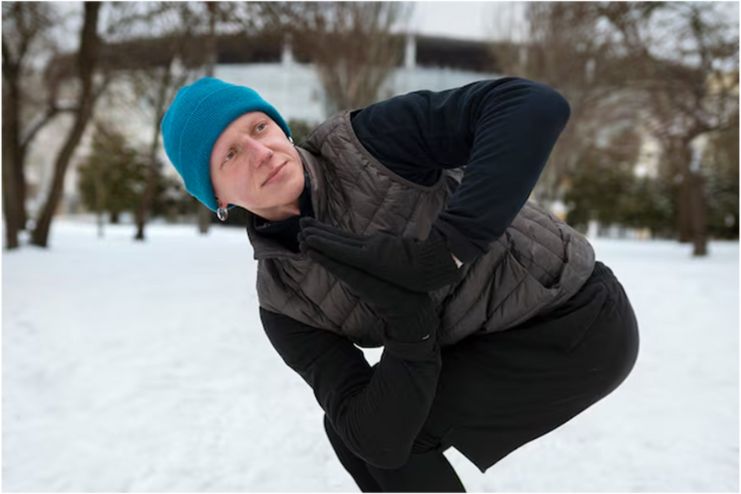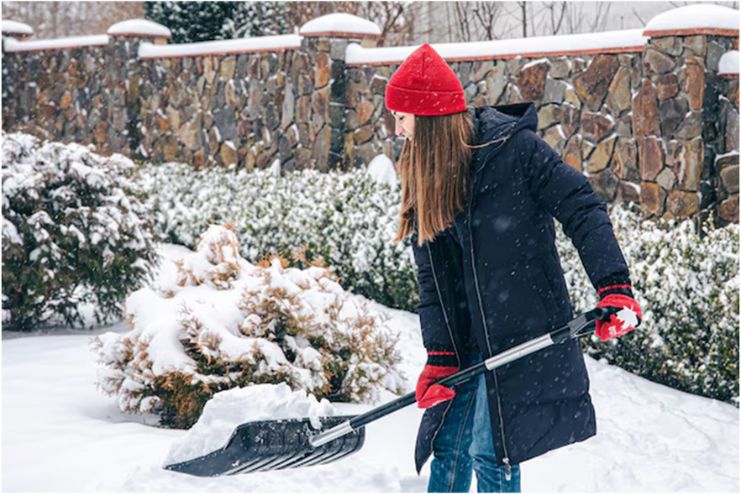Affiliate Disclaimer
Some links in this article are affiliate links. We may earn a small commission if you make a purchase through these links, at no extra cost to you. We only recommend products we find useful to our readersAs winter sets in, it brings more than just chill weather. The cold weather intensifies back pain for many people, and it gets worse for those already struggling with the issue.
Back pain is common and aggravates during winter. Approximately 80% of adults experience back pain at some point in their lives, and most of these people experience it in cold weather. These seasonal back pain complaints have a deeper significance.
Often, cold-weather muscle stiffness affects mobility and overall well-being. However, certain steps can provide some winter back pain relief.
This article explains the reasons behind back pain in cold weather, provides winter back pain relief tips, outlines the best exercises for back pain in winter, and outlines how to maintain healthy back health during winter.
Why Does Cold Weather Worsen Back Pain?

The general feeling associated with cold weather is increased muscle tension, decreased circulation, and alterations in physical activity, all leading to back pain. These factors can help explain why winter aggravates discomfort, thus providing a foundation for effective management strategies.
Muscle Tightening in the Cold:
Cooler temperatures often make muscles stiff. This happens as muscles contract to conserve heat, leading to cold-weather muscle stiffness. Tight muscles are more prone to strains and spasms, leading to extreme discomfort. Moreover, prolonged exposure to cold temperatures can cause muscle fatigue and pain.
Reduced Circulation:
Lower temperatures reduce blood circulation, particularly to the extremities and the back. Poor blood circulation provides fewer essential nutrients to muscles and joints and leads to stiff muscles. Hence, you might experience immense back pain when venturing out in colder climates.
Changes in Physical Activity:
Physical activity and mobility are essential to preventing pain. In winter, we are often less active, leading to weak muscles. Poor posture can also contribute to back pain.
Weather-Induced Stress:
Due to the change in barometric pressure, joints become extremely sensitive in colder months. Individuals suffering from arthritis or pre-existing back pain experience severe back pain in cold weather.
Common Types of Winter Back Pain
Back pain during winter is not the same for everyone. There are various types of back pains experienced by people due to cold weather, with each requiring different kinds of treatment. Here are a few common back pains you might experience during winter.
Chronic Lower Back Pain:
Chronic lower back pain often intensifies during winter. Muscles become stiff, and people experience unpleasant back pain in extreme cold. The increased muscle tension due to winter aggravates existing back pain or back conditions.
Muscle Strain from Snow Shoveling:
Cold and snow mean shoveling. Shoveling can be tough and might cause back pain. You must use proper shoveling techniques and avoid bending at the waist or lifting heavy loads, which can strain the back muscles and lead to injury.
Posture-Related Pain:
Improper posture can contribute to back pain in cold weather. You might slouch on the couch while spending considerable time indoors or hunch over the desk or table to stay warm. All these put undue pressure on your spine and back muscles.
Tips to Manage and Prevent Winter Back Pain
Now that we know the causes of back pain in winter, it becomes essential to understand how to prevent back pain in winter. Here are a few winter back pain prevention tips:
- Stay Active:
As mentioned earlier, immobility causes muscles to become stiff. The more you move your muscles, the less likely you are to experience pain and discomfort. To keep muscles flexible and joints mobile, engage in low-impact exercises such as yoga, walking, or stretching. Read this if you wish to learn quick and effective ways to stay healthy this winter.
- Dress Warmly:
Ensure that you are dressed correctly. Dressing warmly and in layers helps maintain muscle warmth and reduces the chances of muscle stiffness. Use thermal wear and insulated jackets to keep you protected.
- Proper Posture:
Maintaining a neutral posture is crucial. Avoid slouching or hunching to avoid back pain. Improper posture is never recommended, regardless of the season, but particularly in winter.
When to Seek Medical Help for Winter Back Pain
We have addressed the causes of back pain and provided tips to prevent it during winter. It is essential to understand when your pain requires medical attention. Consistent back pain can indicate underlying conditions and might need medical supervision. Here are a few situations where you must consult a healthcare professional to address your back pain issue:
Severe or Constant Pain:
If your back pain persists for more than a few days, you must consult a specialist. If the pain becomes severe and does not get better with rest, heat therapy, or medications, you might be facing a more serious back issue. Not addressing issues on time can lead to herniated discs or spinal stenosis, further aggravating back pain.
Numbness, Tingling, or Weakness:
You must never ignore numbness, tingling, or weakness in your back, legs, or feet. This red flag could indicate nerve compression or other neurological issues, including sciatica. Proper and prompt treatment is essential to avoid further complications.
Pain Accompanied by Other Symptoms:
If you experience more than one symptom accompanying back pain, such as fever, weight loss, or bowel incontinence, immediate medical supervision is needed. These severe symptoms might indicate an infection, a spinal tumor, or a serious condition like cauda equina syndrome, which requires urgent treatment.
If back pain is bothering you, you should know more about it. Explore how back pain while breathing affects you and what you can do about it.
Referral to Specialists:
Sometimes, your primary care doctor might struggle to treat the ailment and refer you to a specialist. Back pain in cold weather can be treated well by a physical therapist, chiropractor, or orthopedic surgeon. These experts can design personalized treatment plans that may include physical therapy, targeted exercises, pain management strategies, or surgical options.
You will learn the difference between simple muscle strain and more serious spinal conditions. This will ensure that you receive the proper care for effective recovery.
Winter-Specific Back Care Tips for Pain Prevention
Knowing the causes of back pain is only the starting point in managing it during winter months. Protecting one’s back through proactive means is very important. Here are some winter-specific tips on how to prevent pain and ensure that the spine remains healthy.
Safe Snow Shoveling Techniques:

As mentioned, shoveling snow with an improper technique can harm your back health. Here are a few best practices for snow shoveling to prevent back pain.
- Use a lightweight shovel with a curved handle. This reduces back strain and helps maintain an upright posture.
- When lifting snow, bend your knees, not your back. This prevents stress on your spine and lower back.
- Instead of lofting, push the snow to reduce lower back pressure.
- Regular breaks every 10-15 minutes allow your muscles to recover.
Maintaining Proper Sleep Posture:

You should snuggle cozy into your bed and blanket during winter. However, incorrect posture during sleep can increase your back pain in cold weather. Here’s how to avoid it:
- Practice side sleeping with a pillow between your knees. This will allow the spine to align properly, and the pillow will keep your hips aligned.
- Practice back sleeping with a pillow under your knees. This posture supports the natural curve of your spine, reducing strain on the lower back.
Ergonomics at Home and Work:

Have proper ergonomics at home. This helps maintain correct posture while relaxing or working from home.
- Invest in a good ergonomic chair.
- Take breaks from sitting for more extended periods.
- Sit with your back straight and avoid slumping or hunching.
Hydration and Nutrition:

You might not feel as thirsty in winter, but hydration is necessary. Dehydration stiffens your joints and muscles and might leave you reeling in discomfort. Ensure you drink plenty of water and warm beverages to keep you comfortable throughout the day.
- Ensure you consume enough calcium and vitamin D, which are vital for bone health and spinal stability.
- Have Foods rich in omega-3 fatty acids, like salmon or flaxseeds. These help reduce inflammation in your muscles and joints.
Hydration is the key to a pain-free back during winter. If you want to start hydrating well, here are 6 insulated water bottles to keep your drinks hot or cold all day.
Home Remedies and Natural Treatments for Winter Back Pain
You can treat the back pain at home if it is not severe. Here are a few natural remedies to manage back pain in cold weather:
- Heat Therapy:
Applying heat to your back can help increase blood flow and relax tight muscles. If a heating pad isn’t available, you can use a warm towel. Moderate heat exposure works well in managing back pain.
- Cold Therapy:
Like heat therapy, cold therapy is effective in reducing inflammation. Applying an ice pack over your back can numb pain and reduce swelling, if any.
- Gentle Stretching:
Exercises to manage back pain are helpful if done right. Stretch your back and hips slowly to relieve tension. Opt for low-impact stretches targeting your lower back and hamstrings.
- Over-the-Counter Pain Relief:
Opt for over-the-counter pain relief nonsteroidal anti-inflammatory drugs (NSAIDs) such as ibuprofen can help reduce pain and inflammation. However, it’s important not to rely on these medications long-term without consulting your doctor, as they can have side effects.
Plenty of home remedies can help you with back pain in cold weather. Read our insightful article to learn more about home remedies for back pain.
Conclusion
Winters do not have to be synonymous with back pain. You can make the most of winter with a healthy back. However, back pain can become worse if you do not take proper care, affecting your overall well-being. Understanding how the factors contribute to back pain and ways to prevent muscle stiffness, improve blood flow, and engage in physical activity can benefit you.
Heat therapy, over-the-counter pain relievers, and specific home remedies are also recommended to manage back pain during cold weather. You can also keep back pain at bay by maintaining a proper posture, good hydration, dressing warmly, and protecting your back.
Say hello to winter and goodbye to back pain with these easy-to-follow, simple winter tips.
References
- https://my.clevelandclinic.org/health/treatments/11086-non-steroidal-anti-inflammatory-medicines-nsaids
- https://my.clevelandclinic.org/health/diseases/22132-cauda-equina-syndrome
- https://www.aans.org/patients/conditions-treatments/low-back-pain/
- https://www.mayoclinic.org/diseases-conditions/spinal-stenosis/symptoms-causes/syc-20352961
- https://pmc.ncbi.nlm.nih.gov/articles/PMC10548303/
- https://www.healthline.com/health/cold-weather-and-joint-pain
In this Article















